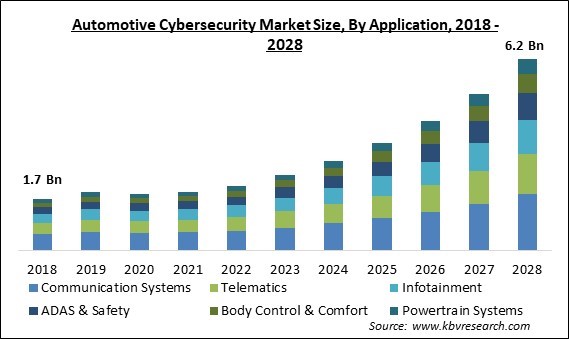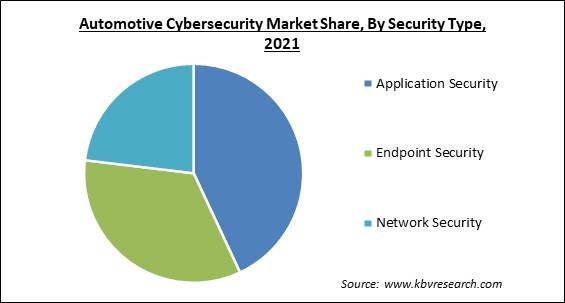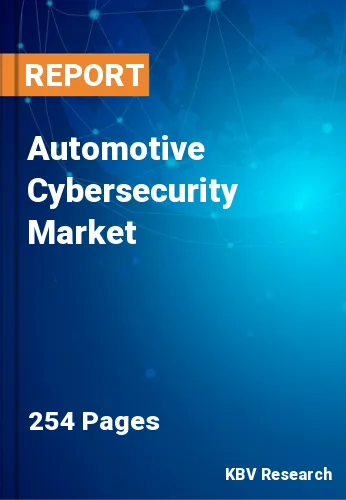The Global Automotive Cybersecurity Market size is expected to reach $6.2 billion by 2028, rising at a market growth of 19.9% CAGR during the forecast period.
A coordinated approach to identifying, defending against, fixing, and avoiding dangers is automotive cyber security. The next generation of automotive cybersecurity vehicles is anticipated to have hardware-based engine control unit protection, software, network monitoring systems to defend them inside the vehicle, and cloud security services. Cybersecurity for automobiles defends the system, which is susceptible to any cyber-attack. Since the majority of automobiles nowadays are internet-connected, the automotive industry is collaborating with internet service providers and other interested parties to offer customers stronger cybersecurity systems.

Driver preferences and desires are changing quickly. Vehicles and the industry as a whole are changing to satisfy consumer aspirations for individualized experiences. Increased personalization and connectivity lead to more software, which increases risk. Similar to how smartphones and smart appliances operate, connected cars can share the internet as well as wireless network access with other cars and external devices. They are capable of transmitting and receiving data. Greater functions and capabilities are already being provided by new software to satisfy the demands and expectations of drivers. In such cases, automotive cybersecurity is essential and ought to be considered during the forecast period.
The market for automotive cybersecurity is anticipated to develop as a result of factors like rising demand for automotive cybersecurity, government attempts to integrate connected car technologies, and the imposition of obligatory cybersecurity requirements. Additionally, it is anticipated that the use of adaptive security to improve vehicle security and the increasing complexity of cars' electronic systems would present in future years.
In order to curb the effect of COVID-19 pandemic, governments across the globe were obliged to impose stringent lockdowns as well as mandate social seclusion. As a result, there was a sharp decline in the market for new cars. Additionally, the raw material supply was reduced, there was a slowdown in manufacturing, and supply systems around the world were disrupted. The adoption of cutting-edge cybersecurity systems has been hampered by the losses experienced by the car industry. The usage of automotive cybersecurity solutions, however, is anticipated to rise with time due to increased demand for connected automobiles and the continuous immunization campaign that is taking place across the globe.
The automobile business is changing as a result of the increased connectivity of vehicles to everything, including traffic lights, parking meters, other vehicles, and much more. Advanced technologies are used throughout, including shared mobility, self-driving cars, electrified vehicles, and advanced driver assistance systems (ADAS). In addition to improving comfort and safety on the roadways, these technologies also expose this complex and dynamic environment to cyberattacks. Attack points grow as the ecosystem becomes more interconnected, revealing new weaknesses that hackers could exploit to endanger car safety, user privacy, and the integrity of automotive data. This increasing need for security against the rising number of connected cars cyberattacks, is anticipated to fuel the expansion of the automotive cybersecurity market over the course of the projected period.
A cybersecurity technology called adaptive security examines actions and occurrences to stop and prepare for threats before they happen. An adaptive security architecture can be used by a company to give proportional enforcement that can be turned up or down while continuously analyzing risk. It is simpler to defend a scattered workforce with adaptive security, which many automotive manufacturers lack throughout their operations. Therefore, during the projected period, these elements in the automobile industry are anticipated to fuel market growth.
The entire ecology of the automotive business is shifting due to the advent of additional services like E-calls, multimedia streaming, and remote diagnostics in connected cars. The automotive ecosystem has changed from being fixed to being dynamic, with a share of revenue is accounted for by each actor. The existence of numerous stakeholders has made the pricing model in the linked ecosystem difficult to implement. Managing the complexity and cost of various pricing strategies is a challenge for many businesses. Software firms currently use multiple pricing models to generate income. According to specialists in the field, cybersecurity solution providers struggle to apply the best pricing plan in a variety of situations in order to increase income and reduce potential loss.
Based on offering, the automotive cybersecurity market is segmented into software and hardware. The hardware acquired a significant revenue share in the automotive cybersecurity market in 2021. OEMs are developing secure vehicles from the beginning by implementing cutting-edge hardware engineering techniques, making sure that different vehicle types are planned, produced, and tested for security flaws, and that any cyber threats are appropriately handled. The automotive cybersecurity market is expanding in this segment.

On the basis of security type, the automotive cybersecurity market is fragmented into application security, network security and endpoint security. In 2021, the network security segment covered a substantial revenue share in the automotive cybersecurity market. The segment will be driven by the growing requirement to provide network security through restricted device management in-vehicle interfaces due to the growing number of linked automobiles and the likelihood of assaults on network interfaces.
By application, the automotive cybersecurity market is divided into ADAS & safety, body control & comfort, infotainment, telematics, powertrain system, and communication system. The ADAS & safety segment accounted a significant revenue share in automotive cybersecurity in 2021. With the use of ADAS technology, cars can be safer, automated, and strengthened for safe driving. This has made possible by a combination of sensors, actuators, processors, mapping systems, and different software systems. The growing concern for traffic and road safety among both governments and individuals is one of the factors driving up demand for ADAS.
Based on form, the automotive cybersecurity market is classified into in-vehicles and external cloud services. In 2021, the in-vehicle segment garnered the largest revenue share in the automotive cybersecurity market. This is due to a surge in demand for safeguarding in-vehicle communications from cyberattacks on cars. The most popular category is in-vehicle services. The demand for in-vehicle services is growing as endpoint applications like radio, mobile, and smart antenna are increasingly used in autos.
| Report Attribute | Details |
|---|---|
| Market size value in 2021 | USD 1.9 Billion |
| Market size forecast in 2028 | USD 6.2 Billion |
| Base Year | 2021 |
| Historical Period | 2018 to 2020 |
| Forecast Period | 2022 to 2028 |
| Revenue Growth Rate | CAGR of 19.9% from 2022 to 2028 |
| Number of Pages | 254 |
| Number of Tables | 449 |
| Report coverage | Market Trends, Revenue Estimation and Forecast, Segmentation Analysis, Regional and Country Breakdown, Companies Strategic Developments, Company Profiling |
| Segments covered | Offering, Form, Security Type, Application, Region |
| Country scope | US, Canada, Mexico, Germany, UK, France, Russia, Spain, Italy, China, Japan, India, South Korea, Singapore, Malaysia, Brazil, Argentina, UAE, Saudi Arabia, South Africa, Nigeria |
| Growth Drivers |
|
| Restraints |
|
Region wise, the automotive cybersecurity market is analyzed across North America, Europe, Asia Pacific and LAMEA. The North America region led the automotive cybersecurity market with the highest revenue share in 2021. Due to increased R&D efforts, technological advancements made by important players, and the quick uptake of novel technologies in the creation of dependable, secure, and safe automotive cybersecurity solutions, these solutions are being widely adopted in the United States.
Free Valuable Insights: Global Automotive Cybersecurity Market size to reach USD 6.2 Billion by 2028
The market research report covers the analysis of key stake holders of the market. Key companies profiled in the report include Robert Bosch GmbH, Continental AG, Denso Corporation, Aptiv PLC, Harman International Industries, Inc. (Samsung Electronics Co., Ltd.), Vector Informatik GmbH, Arilou Information Security Technologies Ltd. (NNG Group), GuardKnox Cyber Technologies Ltd., and Karamba Security Ltd.
By Application
By Security Type
By Offering
By Form
By Geography
The global Automotive Cybersecurity Market size is expected to reach $6.2 billion by 2028.
The rise in automotive cybersecurity needs are driving the market in coming years, however, Differences in pricing tactics between stakeholders restraints the growth of the market.
Robert Bosch GmbH, Continental AG, Denso Corporation, Aptiv PLC, Harman International Industries, Inc. (Samsung Electronics Co., Ltd.), Vector Informatik GmbH, Arilou Information Security Technologies Ltd. (NNG Group), GuardKnox Cyber Technologies Ltd., and Karamba Security Ltd.
The Communication Systems market acquired the maximum revenue share in the Global Automotive Cybersecurity Market by Application in 2021, thereby, achieving a market value of $1.8 billion by 2028.
The External Cloud Services market has shown the high growth rate of 21% during (2022 - 2028). Due to the advancement of cloud infrastructure and framework, external cloud services, the regional market is expanding.
The North America market dominated the Global Automotive Cybersecurity Market by Region in 2021, and would continue to be a dominant market till 2028; thereby, achieving a market value of $2.15 billion by 2028.
Our team of dedicated experts can provide you with attractive expansion opportunities for your business.

